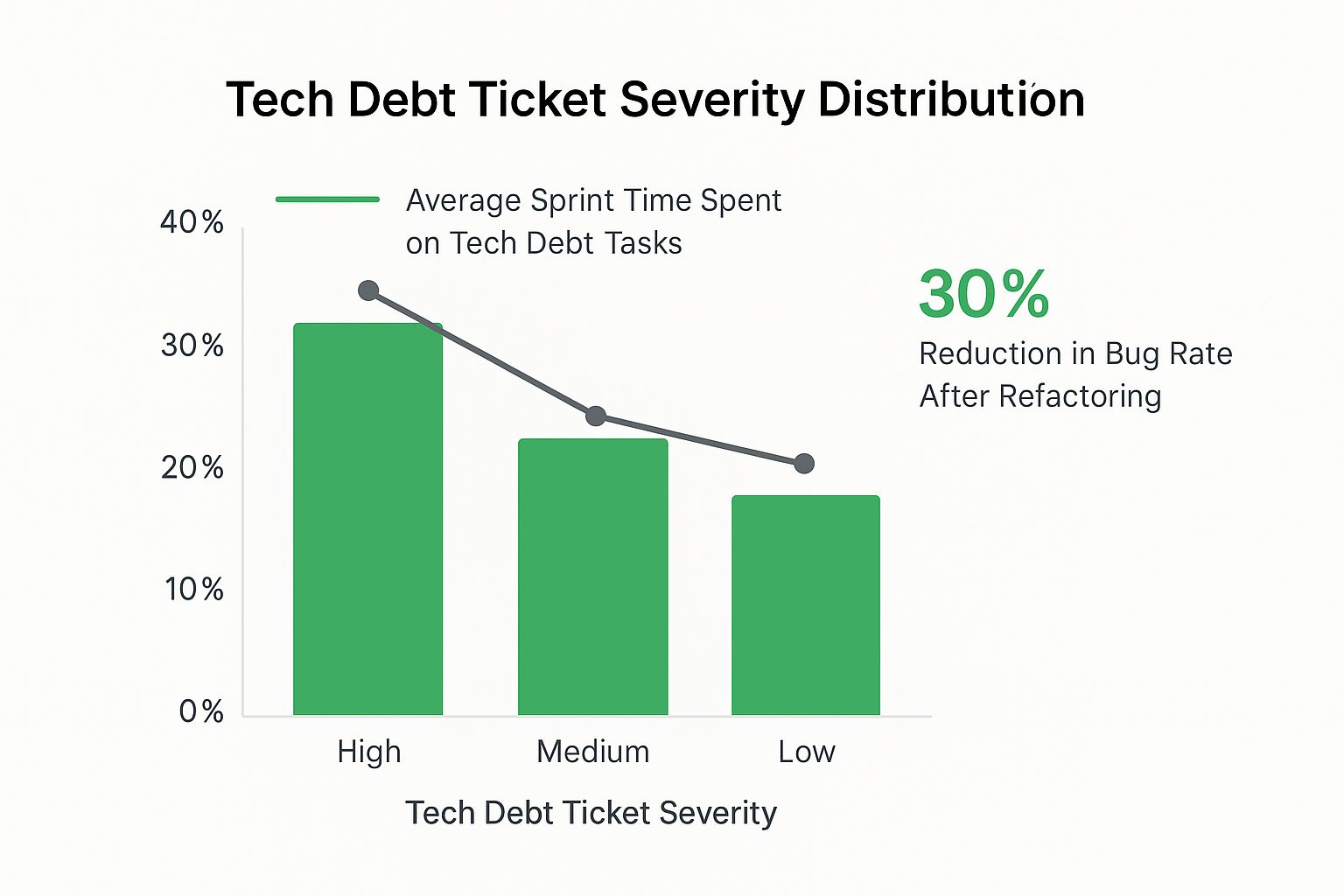Learn how to reduce tech debt efficiently with expert strategies. Improve code quality and prevent future issues. Discover practical tips today!
When we talk about tech debt, it’s tempting to just think of messy code. But in reality, it’s a multi-headed monster lurking in your projects, slowing down your team and quietly draining your budget in ways you might not even see. To actually make a dent in your technical debt, you have to look beyond the immediate codebase.
First things first, you need to know what you’re up against. Tech debt isn’t a single problem; it’s a collection of issues, and each one comes with its own price tag. Here are the usual suspects I see tripping up even the best teams:
Let’s be clear: this isn’t just some abstract problem for the engineering department; it’s a major roadblock for the entire business. As companies push to modernize, they find that unresolved debt acts like an anchor holding them back. Market surveys confirm this urgency. A 2025 Forrester survey found that a staggering nine out of ten technology executives expect their IT spending to increase, with three-quarters planning bigger budgets for software development and talent. This growth is fueled by AI and cloud adoption, which makes the technical environment more complex and magnifies the pain of existing debt. Discover more on this trend.
Spotting these different forms of debt is your first real step toward getting your team’s momentum back. Before you can build a battle plan, you have to understand the real costs. This strategic guide on how to reduce technical debt offers a great starting point. Simply deciding to “fix things” isn’t a strategy. You need a focused approach that targets the specific types of debt dragging you down. By truly identifying your enemy, you can finally choose the right weapons for the fight.
Trying to fix technical debt with random, one-off patches is a losing game. It feels like trying to empty the ocean with a teaspoon—you’ll get soaked, but the water level won’t budge. To make a real impact, you need a proper battle plan that connects your team’s hard work to actual business results. This is the moment you stop just reacting to fires and start strategically managing the health of your codebase for the long haul.

You can’t fix what you can’t see. The first move is a full-stack audit to get a clear picture of all the technical debt hiding in your system, not just the messy code. It’s an honest look in the mirror, a chance to formally acknowledge the problems every developer knows about but nobody has written down. This audit becomes your living inventory of what needs fixing.
Your audit should go beyond surface-level code smells and track:
This can seem like a huge task, but modern tools can make it much faster. For instance, using DocuWriter.ai’s UML diagram generation can instantly map out convoluted architectural debt. It turns an abstract, hard-to-explain problem into a clear visual diagram that your team can actually work with.
To figure out the right depth for your audit, it helps to compare a few common approaches. This table breaks down different methodologies to help you choose the best fit for your team’s current situation.
Ultimately, the right method depends on your goal. If you need a quick win, a triage is great. For a long-term strategy, nothing beats a full-stack audit.
Once your audit shows you what’s wrong, you need to define what right looks like. A vague goal like “write cleaner code” isn’t going to get you very far. Instead, you need to connect your debt reduction work to specific, measurable business outcomes that everyone can understand.
This means setting objectives like, “Reduce new developer onboarding time by 40% by simplifying the core modules,” or “Cut deployment failures by 75% within two quarters by improving test coverage.” This is how to reduce tech debt in a way that gets buy-in from leadership.
And this isn’t just a theory. A disciplined strategy gets real results. Research shows that companies following a structured plan have successfully eliminated over 665 redundant applications and platforms. This led to a stunning 30% reduction in their total enterprise technology footprint. Read the full research on this powerful strategy to see how it’s done.
Your audit and objectives are the key ingredients for your roadmap. This is where you balance quick wins with the major, long-term architectural fixes that will secure your system’s future. A good roadmap often has two parallel tracks: small, incremental refactoring that becomes part of daily work, and larger, dedicated projects to tackle the most systemic issues.
By planning your work this way, you can keep delivering new features and value while methodically chipping away at the underlying problems. This roadmap becomes your team’s North Star and a fantastic tool for showing stakeholders exactly how your engineering efforts are making the business stronger. For a more detailed walkthrough, check out our complete guide on building a tech debt strategy.
After auditing your codebase, you’re likely staring at a backlog of technical debt that seems a mile long, with every item screaming for attention. It’s easy to feel paralyzed. But here’s a secret from seasoned engineering teams: you don’t fix everything. The goal isn’t a perfectly clean slate; it’s being ruthlessly strategic about what you tackle first.
To cut through the noise, I always turn to a simple but incredibly effective tool: the Impact vs. Effort Quadrant. This framework helps you categorize every piece of debt by asking two straightforward questions: How much value will we get from fixing this, and how much work will it take?
This simple visualization instantly clarifies where your priorities should lie.
Laying out your debt this way gives you a clear map of where to direct your team’s energy for the biggest payoff.

This isn’t just theory; the data backs it up. We’ve seen that dedicating just 15% of a sprint to refactoring high-impact issues can lead to a 30% drop in production bug rates.
A quadrant diagram is great for a high-level view, but how do you translate that into your actual sprint backlog? This is where you get quantitative. Ask your team to rate each debt item on a simple 1-5 scale for both business impact and engineering effort.
This exercise transforms subjective debates into objective conversations. An item with an impact score of 5 (high) and an effort score of 1 (low) is an obvious top priority. Conversely, an item with an impact of 1 and an effort of 5 should drop to the very bottom of the list—if it makes the list at all. This approach is a lifesaver when different stakeholders are pushing for their pet projects. You can present a logical case backed by the team’s collective assessment.
To make this even more concrete, here’s a matrix you can adapt for your own planning sessions. It helps translate the abstract quadrants into a tangible action plan.
Priority levels based on impact vs effort, with recommended timeframes and resource allocation
This matrix gives you a clear framework for discussing priorities with both technical and non-technical stakeholders, ensuring everyone is aligned on the “why” behind the roadmap.
Of course, numbers alone don’t tell the whole story. You have to layer on business context. A piece of messy code in your payment processing module is a ticking time bomb, carrying far more risk than the same kind of mess in an internal-only dashboard. Always consider the business criticality of the affected area when scoring. This isn’t just about cleaning up code; it’s about protecting the business and clearing the way for future growth.
Tackling years of accumulated technical debt can feel like a slow, frustrating crawl. But AI-powered tools are changing that reality, handling complex reduction tasks that once took weeks of developer time. This isn’t about replacing engineers; it’s about equipping them with tools that let them bypass the tedious work and focus on building great products.

Let’s be honest, some of the work involved in how to reduce tech debt is a grind—cleaning up functions, untangling dependencies, and enforcing consistency across a huge codebase. This kind of repetitive, pattern-based work is exactly where AI shines.
Tools like DocuWriter.ai bring intelligent features to the table that directly address the sources of debt:
AI gives us a chance to manage technical debt with more precision than ever before. It’s not just a minor annoyance; research shows that technical debt is a real liability that slows down business agility and growth. The most effective teams are looking beyond just fixing bugs. They are creating a ‘debt-to-value’ ratio and building a clear, AI-assisted roadmap to guide their work with data, not just intuition. Explore the full report on smashing tech debt with AI.
This data-first approach is key. After AI tools help you identify and measure your debt, you still have to decide what to fix first. Learning some excellent prioritization techniques will help you focus your energy where it will make the biggest difference. This is how you build a plan that balances quick, morale-boosting wins with essential, long-term architectural improvements.
In the end, picking the right AI tool means finding one whose abilities fit your specific technology stack and team skills. It isn’t a magic fix—it won’t solve deep-rooted cultural problems or make major architectural decisions for you. But for understanding, refactoring, and documenting complex systems at a speed and scale that was previously impossible, AI is the most powerful ally you can have in your fight against technical debt.
Tackling a big chunk of technical debt feels great, but that victory lap is short-lived if the same old habits keep creating new problems. The real goal when learning how to reduce tech debt is to change the way you work so you stop accumulating it. This means weaving new systems and mindsets into your daily development flow until quality becomes a shared responsibility, not a final-gate check.

The best way to prevent future debt is to catch it before a single line of code gets merged. This requires your code review process to be more than a simple “does it work?” check. It needs to become a deep look into the code’s long-term maintainability. This is a big cultural shift, moving the ownership of quality from a QA team to every single developer at the point of commit.
A great principle to instill in your team is the “Boy Scout Rule”: always leave the code a little cleaner than you found it. This doesn’t mean you need to rewrite an entire module every time you touch it. It’s about making small, positive changes as part of your regular work, which prevents the slow, silent decay of a codebase. To make this work, you need clear team agreements on:
Some of the most frustrating technical debt comes from a lack of context. Future developers can see what the system does by reading the code, but they can almost never see why it was built that way. This is where Architectural Decision Records (ADRs) are incredibly useful. An ADR is just a simple text file, checked into your repository, that captures a key architectural choice, the context around it, and its consequences.
Think of ADRs as time capsules for your team’s reasoning. They answer that future developer’s question: “Why on earth did we choose this message queue over that one?” This simple habit stops engineers from wasting days second-guessing old decisions or, even worse, accidentally re-introducing a problem that was already solved. While some of the most beneficial uses of AI can help automate the “what” documentation, it’s this crucial “why” that requires a human touch.
The secret to making these practices stick is to make doing the right thing the easy thing. You can achieve this with automation that gives developers fast, direct feedback. Tools like automated linters, static analyzers, and a solid test suite aren’t meant to be annoying roadblocks; they are designed to catch potential issues early, before they take root.
These systems act as guardrails, not gates. The point isn’t to block a developer’s progress but to gently guide them toward better patterns in real time. This creates a tight feedback loop that reinforces your quality standards without destroying your team’s velocity. This is how you make quality the default path, not the difficult one, and build a codebase that can support innovation instead of crumbling under its weight.
So you’ve rolled up your sleeves and started chipping away at your technical debt. That’s a huge first step. But now comes the real challenge: proving to yourself, your team, and the higher-ups that your efforts are actually paying off. Refactoring code is one thing, but showing it wasn’t just busywork is another.
Without clear metrics, your project to clean up the codebase can quickly be dismissed as an engineering “pet project” instead of a critical business investment. True success isn’t just about having cleaner code; it’s about delivering measurable improvements that everyone in the company can understand and appreciate.
It’s easy to get lost in vanity metrics that look good on a chart but don’t mean much. Instead, you need to track indicators that directly connect the health of your code to the health of the business. A solid dashboard will tell a compelling story of progress by blending technical stats with business outcomes.
Here are a few metrics that actually tell you something useful:
Showing these numbers to stakeholders is how you get buy-in and secure the resources to continue. But don’t just email a spreadsheet and hope for the best. Your job is to translate those technical wins into tangible business impact.
A simple, visual report can do wonders. It keeps everyone invested, from the product manager to the CFO. Here’s a straightforward template you can adapt to show your progress:
Let’s be honest: a long-term refactoring initiative can be a grind. The initial excitement can fade, leaving developers feeling like they’re on a never-ending cleanup mission. To keep the momentum going, you have to celebrate the small victories along the way.